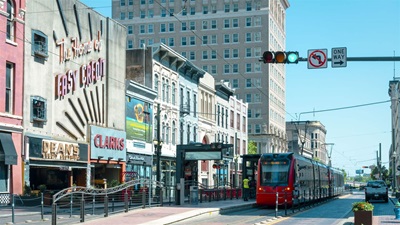Can Manufactured Homes Help Solve the Nation’s Housing Shortage?
At a time of high rents and housing prices, manufactured homes offer an alternative—but they face regulatory hurdles that lawmakers can fix.

Hector Cardenas was skeptical.
His wife had fallen in love with a four-bedroom, two-bath single-family home that their real estate agent showed them in Petersburg, Virginia. The city of 34,000 was close to Fort Gregg-Adams, where Cardenas, a U.S. Marine instructor, would be based after the couple moved from Temecula, California.
The house was a manufactured home, which he had never heard of, so Cardenas began to research. Some sources dismissed the houses as being built with cheaper products and likened them to the single- or double-wide trailers of previous generations. But federal standards for the homes had been updated in recent decades, boosting quality—and the price was hard to ignore.
The 1,400-square-foot house was going for $240,000, whereas others near the military base that listed for up to $100,000 more were often “not in pristine condition” and would require work upon move-in, he says. The couple took a chance and bought it.
Regrets?
“None at all,” he says. “There’s so much room! I can’t emphasize that enough.” The house features an open-plan concept with an island kitchen, a porch, and a front- and backyard. And the couple has been pleased with the quality of construction. “We’ve had zero problems with it,” says Cardenas. “I’d buy another.”
Manufactured homes such as Cardenas’ may offer an answer to the current shortage in the U.S. housing market. An estimated nationwide shortage of 4 million to 7 million homes has pushed rents to all-time highs, leaving a record share of Americans spending more than 30% of their income on rent. At the same time, the median home price has jumped to $420,000, leaving families unable to afford a house, forcing them to continue renting and miss out on the benefits of homeownership.
Manufactured homes are assembled on a chassis, or framework of a vehicle, that’s permanently affixed to the house. They are built according to U.S. Department of Housing and Urban Development standards that were updated after hurricanes in the 1970s destroyed thousands of flimsy trailer-style homes and now allow more modern and accessible designs. According to research by the Harvard Joint Center for Housing Studies (JCHS) funded by The Pew Charitable Trusts, new manufactured homes cost buyers up to two-thirds less than building similarly sized single-family homes. And besides being less expensive, they can be produced quickly.
At the Eagle River Homes production plant in Leola, Pennsylvania, a manufactured home rolls out of the warehouse every three days, the company’s marketing manager, Lloyd Black, says as he stands in front of one of the 17 stations—each the size of a house—on the production line. Behind him, a house under assembly has a foundation, interior walls built around the water lines running up through the floor, and a vanity, toilet, and shower/bathtub combo. As it moves along the line to the next station, the structure takes shape, receiving insulation, walls around the fixtures, a roof, moldings, siding, lights, shingles, windows and doors, and appliances. At the final station, a foreman walks the unit and signs off. Then, the home will be ready for the highway and delivery to its destination. And, after that, it will likely never move again.
In addition to a quick production time, the homes—which can be as big as 1,800 square feet—are built inside a facility, shielding them from bad weather and rain delays. “If [construction workers] were building that house outside when it’s raining, the lumber is sitting there, getting wet,” says Black. “In here, there’s no weather damage. If you exceed moisture content, you can’t use the lumber. Our inspections are more stringent than a stick-built house”—industry lingo for site-built homes—“can be.”
From the outside, many manufactured homes look nearly identical to lot-built ones, even those in the same neighborhood. And on the inside, many of the furnishings also look the same: finished sheet rock, dual glazed windows, attractive roof pitches, walk-up attics, wooden cabinets and ceramic tiles in the kitchen and bath, and porches.
They no longer resemble the prefab trailers that many picture when they think of manufactured houses. “Misconceptions come from people who just haven’t seen our product,” says Black.
New construction at an affordable price gives “the missing middle market” more options, according to Tom Heinemann, a developer who specializes in affordable homes and manufactured houses and is selling and renting the houses in a new community in Hagerstown, Maryland, and in Petersburg, where Cardenas purchased his home. “One of the things we’ve found with manufactured homes is that they hit a certain market just right,” he says. In Petersburg, the manufactured houses are priced between $250,000 and $280,000, and in Hagerstown, between $330,000 and $370,000.
“We’re hitting a lot of sweet spots. It’s not just one demographic,” says Black. “It’s young, middle ages, and retirees.”
But despite the affordability of manufactured homes, buying one can still be difficult for many who need and want them. Traditionally constructed homes are automatically titled as real estate. But almost every state automatically titles manufactured homes as personal property, like an automobile, regardless of the quality of the home or whether the homebuyer owns the land where the house will sit.
Pew research shows that only 44% of manufactured home borrowers have a mortgage—compared with 95% of site-built home borrowers. Home-only loans, which are also known as personal property or chattel loans, are an option but can be hard to get and come with higher interest rates, shorter repayment periods, and fewer protections than mortgages.
One in 5 manufactured home borrowers end up resorting to much riskier contract financing such as lease-purchase or contract for deed, in which actual homeownership doesn’t transfer until the final payment—especially common among borrowers whose homes are titled as personal property. That puts borrowers at a much higher risk of eviction with little notice, foreclosure, loss of their house, and a loss of equity.


“Potential buyers who are looking for an affordable home—first-time homebuyers, single-income earners, retirees, and lower-middle-income workers—could really benefit from changes to safer, more affordable financing options,” says Rachel Siegel, who works with Pew’s housing policy initiative.
Those buyers are also potentially good candidates for safer loans. Of manufactured home borrowers, 89% report being current on their loans, and only 4% report being behind on payments by three or more months, says Siegel.
“States need to modernize title laws,” she says. “Manufactured homes are not the trailers of yesterday and need not be treated that way.”
The same outdated views of low-quality trailer homes that have created financing concerns have also led to zoning restrictions, particularly in suburban or urban areas, that do not allow manufactured homes in single-family neighborhoods.
Changes to zoning laws and permitting would also allow more manufactured homes to help fill vacant lots, replace decrepit unoccupied houses, or create new subdivisions—and allow access to affordable homes. The JCHS research found that policymakers in hundreds of counties in the U.S. can expand access to manufactured homes and help 3.2 million moderate-income renters become homeowners. Many of these individuals, who earn between $50,000 and $100,000, might not be able to afford a site-built single-family house but would likely be able to purchase a manufactured home, according to the research.
Some state policymakers have taken steps to help expand access to these affordable homes. In 2024, Maryland, Maine, New Hampshire, and Rhode Island enacted laws to prevent zoning barriers for manufactured homes so that they can be built where single-family homes are allowed.
Proponents of manufactured homes say that they also can boost local economies. As more homes become available, other businesses to serve those residents come, too. The 46 vacant lots that Heinemann is developing for manufactured homes in Petersburg “are a catalyst,” he says. “Now you see lots of other development.”
And buyers like them. Cardenas has settled into his place—easily. “Downsides? I haven’t seen them,” he says. “The quality is good, and we’ve had no issues.” He also checked the real estate listings for manufactured homes like his in the area and was pleased to see they’re now going for more than he paid. Says Cardenas, “I’ve even made money.”
Carol Kaufmann is a Trust staff writer.
Explore the Issue































